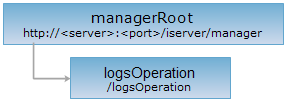<managerRoot_uri>/logsOperation[.<format>]
logsOperation resource is used to get the operation logs of server. Operation logs mean the operations of service administrator and the editing records of service visitor for the detailed GIS service, such as adding, modification, deletion and so on. The operation log only has (INFO) a level.
Supported Methods:
Supported output formats: rjson, json, html, xml.

Implement the HTTP request on the following URI, where supermapiserver is the server name, with rjson being the output format.
http://supermapiserver:8090/iserver/manager/logsOperation.rjson
Gets the operation log of server.
When implementing GET request on the logsOperation resource, the following parameters are contained in URI, used to control entry number.
| Name | Type | Description |
| count | int | [Optional parameter] Entry number. The latest N operations. Default is 20. |
The reponse result is the operation log record array. The response structure is as follows:
| Field | Type | Description |
| className | String | The class name. |
| date | String | The log time. |
| line | String | The separator, i.e., "-". |
| logLevel | Level | the log level. |
| message | String | Summary. |
| packageName | String | The package name. |
| stackTrace | String | The stack information, i.e., the error tracking information. |
Implement GET request on logsOperation resource http://localhost:8090/iserver/manager/logsOperation.rjson?count=3. You can get the latest 3 operation logs. The returned rjson format representation is as follows:
[
{
"className": null,
"date": "2014-10-16 10:11:56",
"line": null,
"logLevel": {
"name": "INFO",
"priority": 200
},
"message": "Update the permissions of service instance data-ChinaProvinces/rest successfully. (userName:admin; clientAddress:0:0:0:0:0:0:0:1; requestURL:http://localhost:8090/iserver/manager/instances/authorize.json ) ",
"packageName": null,
"stackTrace": ""
},
{
"className": null,
"date": "2014-10-16 10:11:56",
"line": null,
"logLevel": {
"name": "INFO",
"priority": 200
},
"message": "Update the permissions of service instance components-rest/rest successfully. (userName:admin; clientAddress:0:0:0:0:0:0:0:1; requestURL:http://localhost:8090/iserver/manager/instances/authorize.json ) ",
"packageName": null,
"stackTrace": ""
},
{
"className": null,
"date": "2014-10-16 10:11:56",
"line": null,
"logLevel": {
"name": "INFO",
"priority": 200
},
"message": "Update the permissions of service instance components-handler/handler successfully. (userName:admin; clientAddress:0:0:0:0:0:0:0:1; requestURL:http://localhost:8090/iserver/manager/instances/authorize.json ) ",
"packageName": null,
"stackTrace": ""
}
]
Asks for the response identical to the one that would correspond to a GET request, but without the response body. This is useful for retrieving meta-information written in response headers, without having to transport the entire content. The meta-information includes the media-type, content-encoding, transfer-encoding, content-length, etc.
HEAD request can be used to check if the logsOperation resource exists, or if the logsOperation resource can be accessed by clients. It can also determine if the logsOperation resource supports an output format <format> if performed on a URI with .<format> included.